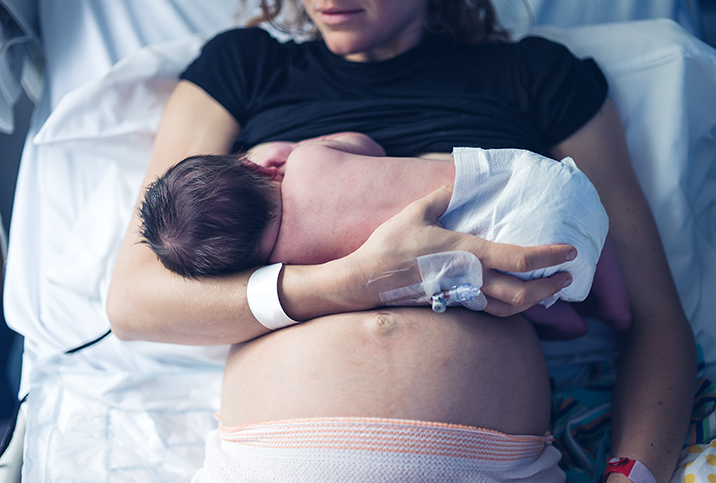Is Membrane Stripping an Effective Method to Induce Labor?

Toward the end of pregnancy, women start thinking about natural ways to induce labor in case their baby gets too cozy and shows no signs of leaving the womb by their due date. Tips include exercise, acupuncture, nipple stimulation, sex and spicy foods, to name a few. However, if none of these works, there is another natural way of inducing labor.
Membrane stripping, also called a membrane sweep, is a safe and effective preinduction cervical ripening technique that can be performed without hospitalization.
A doctor or midwife can carry out the procedure anytime after 38 weeks—depending on the indication—as it can increase the chance of spontaneous labor by 20 percent in the following seven days, explained Zahra Ameen, M.B.B.S., a consultant OB-GYN at Cadogan Clinic, headquartered in London.
"During a membrane stripping procedure, a doctor/midwife will insert one or two gloved fingers into a person's cervix and sweep between the thin membranes of the amniotic sac. This is a thin-walled sac around the fetus. This stimulates chemical release from the cervix—hormone and prostaglandin production—which helps induce labor," she said.
Research behind the effectiveness of the technique
When continuing with a pregnancy becomes more harmful for a woman or the baby than the potential side effects of having an induction, mom-to-bes are offered to be induced, according to Cochrane, an independent global source of healthcare information.
A 2020 systematic review analyzed 44 randomized studies that included 6,940 women from a wide variety of countries, and all income backgrounds, to determine whether the membrane sweeping procedure is safe and could be more effective than formal induction of labor.
Based on the research of 40 studies involving 6,548 women that compared this method to no induction or a sham sweep, the study found women were more likely to have spontaneous onset of labor. However, researchers found no clear difference between the groups for unassisted vaginal births. They also didn't discover apparent differences between the groups for instrumental vaginal deliveries, cesarean section or serious illness or death of mother or baby.
Who can benefit?
"[Membrane stripping] can be carried out for women who are over their due date and would like to have the best possible chance of spontaneous labor rather than moving straight to induction of labor with medication," Ameen said.
While there are other scenarios where the procedure can be recommended, it's important to note that each pregnancy is different, and doctors make recommendations on a case-by-case basis after full discussion with the woman, she added.
Effectiveness of this procedure
Membrane stripping is not a guaranteed method for labor induction. Still, as some research suggests, it can help avoid a medical induction, said Monte Swarup, M.D., a board-certified OB-GYN in Arizona and founder of HPV Hub.
"Factors for success include: you are past your due date or over 40 weeks pregnant, you're in the early stage of labor, [or] your cervix is thin, softened and dilated," he said.
Potential risks
While membrane stripping is considered safe, possible risks such as discomfort, cramping, water breaking during the process or bleeding after the procedure are all possible, Swarup added.
You should not worry about your baby having an increased chance of getting an infection if you choose to undergo the procedure, according to the National Health Service (NHS) in the United Kingdom.
"If you have any concerns after a cervical sweep through, [for example,] significant fresh vaginal bleeding, severe abdominal pain or reduced fetal movements, then please don't hesitate to contact your midwife, doctor, or maternity unit for further advice and possible assessment," Ameen concluded.
The procedure can be uncomfortable or painful—people describe it as a rough cervical examination—but it takes only a few minutes, according to Cleveland Clinic. After a successful membrane sweep, contractions might start within a few hours.
While every person and pregnancy are different, labor tends to begin within 48 hours after the procedure. Signs of labor include cramping or pelvic pain, spotting or light bleeding, contractions, losing your mucus plug and your water breaking.
Cleveland Clinic noted that membrane sweeping is most effective at 40 weeks for women who have never given birth before. Those who have had at least one baby should undergo the procedure closer to 41 weeks for better effectiveness. Research found 90 percent of women who tried the method gave birth by 41 weeks, compared with 75 percent of those who did not go for a membrane sweep.
The membrane stripping technique has been available since the 17th century and is still practiced today. However, recent research about its role in the modern world concluded that its continued use should be questioned. The study also highlighted that the success rate of spontaneous labor, 21 percent, should be weighed against the potentially harmful effects of the procedure.


















